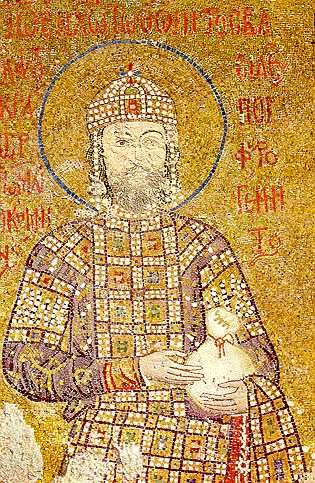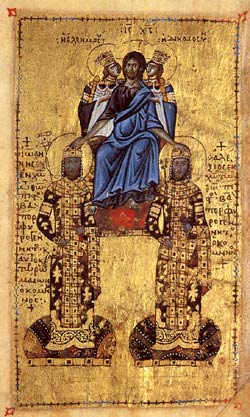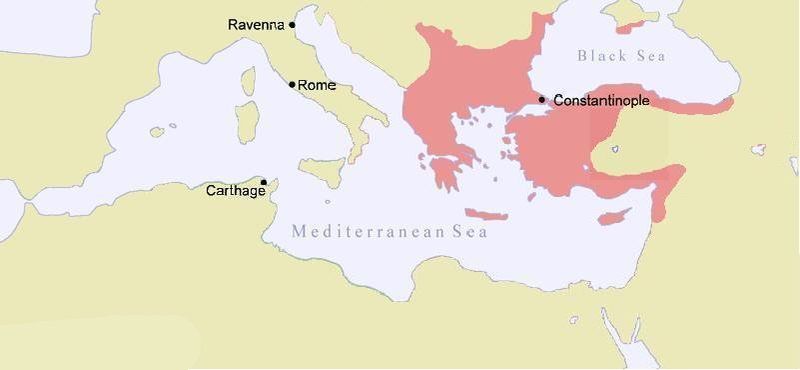<Back to Index>
- Jurist and Prime Minister of Japan Kijūrō Shidehara, 1872
- Composer Girolamo Frescobaldi, 1583
- Emperor of the Byzantine Empire John II Komnenos, 1087
PAGE SPONSOR


John II Komnenos (or Comnenus) (Greek: Ίωάννης Β΄ Κομνηνός) (September 13, 1087 – April 8, 1143) was Byzantine Emperor from 1118 to 1143. Also known as Kaloïōannēs ("John the Beautiful"), he was the eldest son of Emperor Alexios I Komnenos and Irene Doukaina. The second Emperor of the Komnenian restoration of the Byzantine Empire, John was a pious and dedicated emperor who was determined to undo the damage his Empire had suffered at the battle of Manzikert, half a century earlier.
In the course of his twenty - five year reign, John made alliances with the Holy Roman Empire in the west, decisively defeated the Pechenegs in the Balkans, and personally led numerous campaigns against the Turks in Asia Minor. John's campaigns fundamentally changed the balance of power in the east, forcing the Turks onto the defensive and restoring to the Byzantines many towns, fortresses and cities right across the peninsula. In the southeast, John extended Byzantine control from the Maeander in the west all the way to Cilicia and Tarsus in the east. In an effort to demonstrate the Byzantine emperor's role as the leader of the Christian world, John marched into the Holy Land at the head of the combined forces of Byzantium and the Crusader states; yet despite the great vigour with which he pressed the campaign, John's hopes were disappointed by the treachery of his Crusader allies, who deliberately failed to fight against the Muslim enemy at the crucial moment. Also under John, the empire's population recovered to about 10 million people.
The Latin historian William of Tyre described John as short and unusually ugly, with eyes, hair and complexion so dark he was known as 'the Moor'. Yet despite his physical appearance, John was known as Kaloïōannēs, "John the Handsome" or "John the Beautiful". The epithet referred not to his body but to his soul. Both his parents had been unusually pious and John surpassed them. Members of his court were expected to restrict their conversation to serious subjects only. The food served at the emperor's table was very frugal and John lectured courtiers who lived in excessive luxury. Despite his austerity, John was loved. His principles were sincerely held and his integrity great.
John
was famed for his piety and his remarkably mild and just reign. He is
an exceptional example of a moral ruler, at a time when cruelty was the
norm. He never condemned anyone to death or mutilation. Charity was
dispensed lavishly. For this reason, he has been called the Byzantine Marcus Aurelius.
By the personal purity and piety of his character he effected a notable
improvement in the manners of his age. Gifted with great self control
and personal courage, John was an excellent strategist and an expert imperator in the field, and through his many campaigns he devoted himself to the preservation of his empire. He succeeded his father in 1118, but had already been proclaimed co-emperor by Alexios I on September 1, 1092. Niketas Choniates alone
tells of the actions by which John II secured his own succession.
Alexios I had favoured John to succeed him over his wife Irene's
favourite, the Caesar Nikephoros Bryennios, who was married to their daughter Anna Komnena.
Alexios resorted to dissimulation in order to avert Irene's criticism
of his choice and her demands that Nikephoros should succeed. As Alexios
lay on his deathbed in the monastery of the Mangana on 15 August 1118,
John, consorting with relatives whom he could trust, among whom was his
brother, the sebastokratōr Isaac Komnenos,
stole into the monastery and removed the imperial signet ring from his
dying father. Then, taking up arms, he rode to the Great Palace,
gathering the support of the citizenry who acclaimed him emperor. Irene
was taken by surprise and was unable either to persuade her son to
desist, or to induce Nikephoros to act against him. Although the palace
guard at first refused to admit John without proof of his father's
wishes, the mob surrounding the new emperor simply forced entry. Alexios
died the following night. John refused to join the funeral procession,
in spite of his mother's urging, because his hold on power was so
tenuous. However, in the space of a few days, his position was secure.
In 1119, John II uncovered a conspiracy to overthrow him which
implicated his mother and sister, who were duly relegated to
monasteries. To safeguard his own succession, John crowned his own young
son Alexios co-emperor in 1122.
These
political intrigues probably contributed to John's style of rule, which
was to appoint men from outside the imperial family to help him govern
the empire. John's closest adviser was his closest friend, John Axuch,
a Turk who had been given as a gift to John's father. Alexios had
thought him a good companion for John, and so he had been brought up
alongside John, who immediately appointed him as Grand Domestic upon
his accession. The Grand Domestic was the commander in chief of the
Byzantine armies. This was an extraordinary move, and a departure from
the nepotism that had characterised the reign of his father Alexios. The
imperial family harboured some degree of resentment at this decision,
which was reinforced by the fact that they were required to make obeisance to
John Axouch whenever they met him. Yet the emperor had complete
confidence in his appointees, many of whom had been chosen on merit
rather than their relation to him by blood. John's unwillingness to
allow his family to interfere too much in his government was to remain
constant for the rest of his reign.
After his accession, John II had refused to confirm his father's 1082 treaty with the Republic of Venice,
which had given the Italian republic unique and generous trading rights
within the Byzantine Empire. Yet the change in policy was not motivated
by financial concerns. An incident involving the abuse of a member of
the imperial family by Venetians led to a dangerous conflict, especially
as Byzantium had depended on Venice for its naval strength. After a
Byzantine retaliatory attack on Kerkyra,
John exiled the Venetian merchants from Constantinople. But this
produced further retaliation, and a Venetian fleet of 72 ships plundered Rhodes, Chios, Samos, Lesbos, Andros and captured Kefalonia in the Ionian Sea. Eventually
John was forced to come to terms; the war was costing him more than it
was worth, and he was not prepared to transfer funds from the imperial
land forces to the navy for the construction of new ships. John
re-confirmed the treaty of 1082. Nevertheless, this embarrassment was
not entirely forgotten, and it seems likely that it played a part in
inspiring John's successor (Manuel I Komnenos) to re-establish a powerful Byzantine fleet some years later. In 1119 – 1121 John defeated the Seljuq Turks, establishing his control over southwestern Anatolia. However, immediately afterwards, in 1122, John quickly transferred his troops to Europe to fight off a Pecheneg invasion into Moesia. These invaders had been auxiliaries of the Prince of Kiev. John surrounded the Pechenegs as they burst into Thrace,
tricked them into believing that he would grant them a favourable
treaty, and then launched a devastating surprise attack upon their
larger camp. The ensuing Battle of Beroia was
hard fought, but by the end of the day John's army had won a crushing
victory. This put an end to Pecheneg incursions into Byzantine
territory, and many of the captives were settled as foederati within the Byzantine frontier. John then launched a punitive raid against the Serbs, many of whom were rounded up and transported to Nicomedia in
Asia Minor to serve as military colonists. This was done partly to cow
the Serbs into submission (Serbia was, at least nominally, a Byzantine
protectorate), and partly to strengthen the Byzantine frontier in the
east against the Turks. However, John's marriage to the Hungarian princess Piroska involved him in the dynastic struggles of the Kingdom of Hungary.
Giving asylum to a blinded claimant to the Hungarian throne (called
Álmos), John aroused the suspicion of the Hungarians, and was
faced with an invasion in 1128. The Hungarians attacked Belgrade, Braničevo, Nish, Sofia, and penetrated south as far as the outskirts of Philippopolis. After a challenging campaign lasting two years, the emperor managed to defeat the Hungarians and their Serbian allies at the fortress of Haram which is located in Nova Palanka, and peace was restored.
John
planned a new expedition to the East, including a pilgrimage to
Jerusalem on which he planned to take his army with him. King Fulk of Jerusalem, fearing an invasion, begged the emperor to only bring an army of 10,000 men with him. This resulted in John II deciding not to go. However, on Mount Taurus in Cilicia,
on April 8, 1143, he was accidentally infected by a poisoned arrow
while out hunting. The poison set in, and shortly afterwards he died.
John's final action as emperor was to choose his youngest son Manuel Komnenos to
be his successor. John cited two main reasons for choosing Manuel over
his older surviving son Isaac Komnenos: these were Isaac's irascibility,
and the courage that Manuel had shown on campaign at Neocaesareia. Another theory alleges that the reason for this choice was the AIMA prophecy which foretold that John's successor should be one whose name began with an "M". John's eldest son, the co-emperor Alexios, had died in the summer of 1142. Historian J. Birkenmeier has recently argued that John's reign was the most successful of the Komnenian period. In The development of the Komnenian army 1081 – 1180, he
stresses the wisdom of John's approach to warfare, which focused on
siege warfare rather than risky pitched battles. Birkenmeier argues
that John's strategy of launching annual campaigns with limited,
realistic objectives was a more sensible one than that followed by his
son Manuel I.
According to this view, John's campaigns benefited the Byzantine Empire
because they protected the empire's heartland, which lacked reliable
borders, while gradually extending its territory in Asia Minor. The
Turks were forced onto the defensive, while John kept his diplomatic
situation relatively simple by allying with the Holy Roman Emperor
against the Normans of Sicily. Overall,
what is clear is that John II Komnenos left the empire a great
deal better off than he had found it. Substantial territories had been
recovered, and his successes against the invading Pechenegs, Serbians
and Seljuq Turks, along with his attempts to establish Byzantine
suzerainty over the Crusader States in Antioch and Edessa,
did much to restore the reputation of his empire. His careful,
methodical approach to warfare had protected the empire from the risk of
sudden defeats, while his determination and skill had allowed him to
rack up a long list of successful sieges and assaults against enemy
strongholds. By the time of his death he had earned near universal
respect, even from the Crusaders, for his courage, dedication and piety.
His early death meant his work went unfinished — his last campaign
might well have resulted in real gains for Byzantium and the Christian
cause.
John II Komnenos married Princess Piroska of Hungary (renamed Irene), a daughter of King Ladislaus I of Hungary in 1104; the marriage was intended as compensation for the loss of some territories to King Coloman of Hungary.
She played little part in government, devoting herself to piety and
their large brood of children. Irene died on August 13, 1134 and was
later venerated as Saint Irene. John II and Irene had 8 children.
John
was then able to concentrate on Asia Minor, which became the focus of
his attention for most of his remaining years. The Turks were pressing
forward against the Byzantine frontier in western Asia Minor, and John
was determined to drive them back. In 1119, the Seljuqs had cut off Antalya from the empire, John II led an army to capture Laodicea and Sozopolis, therefore reestablishing the land links to the city. He undertook a campaign against the Danishmendid emirate in Malatya on the upper Euphrates from
1130 to 1135. Thanks to John's energetic campaigning, Turkish attempts
at expansion in Asia Minor were halted, and John prepared to take the
fight to the enemy. In order to restore the region to Byzantine control,
John led a series of well planned and executed campaigns against the
Turks, one of which resulted in the reconquest of the ancestral home of
the Komneni at Kastamonu, then he left a garrison of 2,000 men at Gangra. John
quickly earned a formidable reputation as a wall - breaker, taking
stronghold after stronghold from his enemies. Regions which had been
lost to the empire ever since the Battle of Manzikert were recovered and garrisoned. Yet resistance, particularly from the
Danishmends of the north-east, was strong, and the difficult nature of
holding down the new conquests is illustrated by the fact that Kastamonu
was recaptured by the Turks even as John was in Constantinople
celebrating its return to Byzantine rule. John persevered, however, and
Kastamonu soon changed hands once more. John advanced into north eastern
Anatolia, provoking the Turks to attack his army. Yet once again John's
forces were able to maintain their cohesion, and the Turkish attempt to
inflict a second Manzikert on the emperor's army backfired when the
Sultan, discredited by his failure to defeat John, was murdered by his
own people. In 1139, the Emperor marched one final time against the Danishmend Turks, his army marched along the southern coast of the Black Sea through Bithynia, and Paphlagonia. Turning south at Trebizond, he besieged but failed to take the city of Neocaesarea.
The emperor then directed his attention to the Levant, where he sought to re-inforce Byzantium's suzerainty over the Crusader States. In 1137 he conquered Tarsus, Adana, and Mopsuestia from the Principality of Armenian Cilicia, and in 1138 Prince Levon I of Armenia and most of his family were brought as captives to Constantinople. This opened the route to the Principality of Antioch, where Prince Raymond of Poitiers recognized
himself the emperor's vassal in 1137, and John arrived there in triumph
in 1138. There followed a joint campaign as John led the armies of
Byzantium, Antioch and Edessa against
Muslim Syria. Although John fought hard for the Christian cause in the
campaign in Syria, his allies Prince Raymond of Antioch and Count Joscelin II of Edessa sat around playing dice instead of helping John to press the siege of Shaizar.
These Crusader Princes were suspicious of each other and of John, and
neither wanted the other to gain from participating in the campaign,
while Raymond also wanted to hold on to Antioch, which he had agreed to
hand over to John if the campaign was successful in capturing Aleppo, Shaizar, Homs, and Hama. While the emperor was distracted by his attempts to secure a German alliance against the Normans of Sicily, Joscelin and Raymond conspired to delay the promised handover of Antioch's citadel to the emperor.
